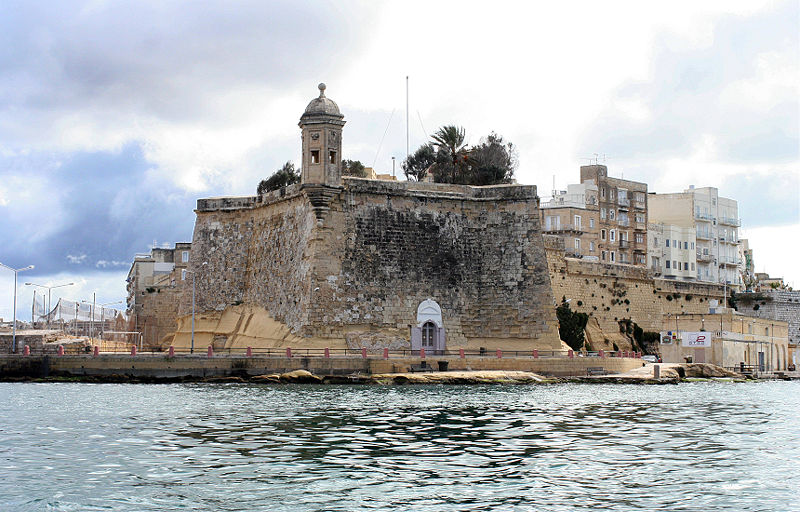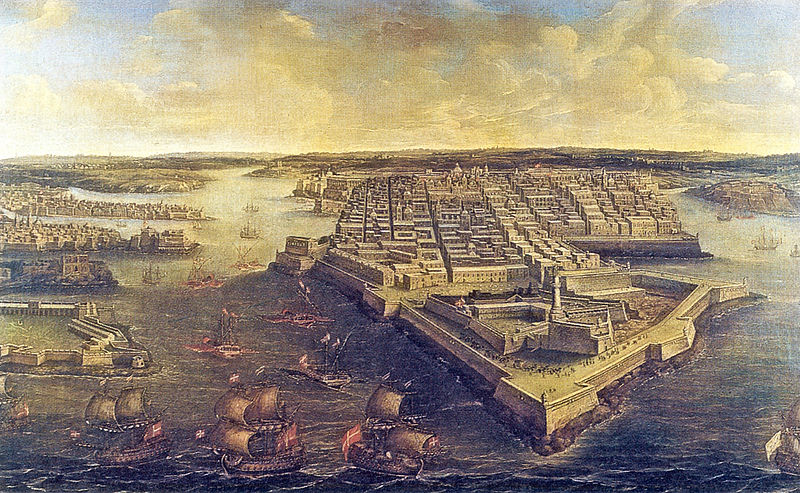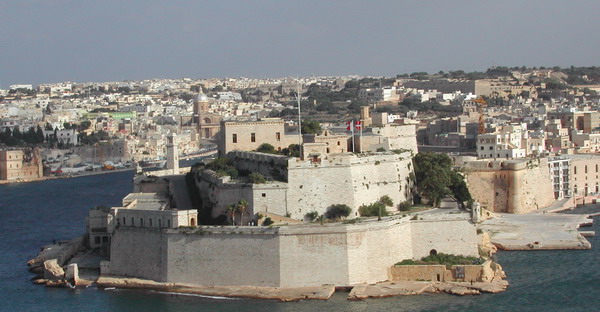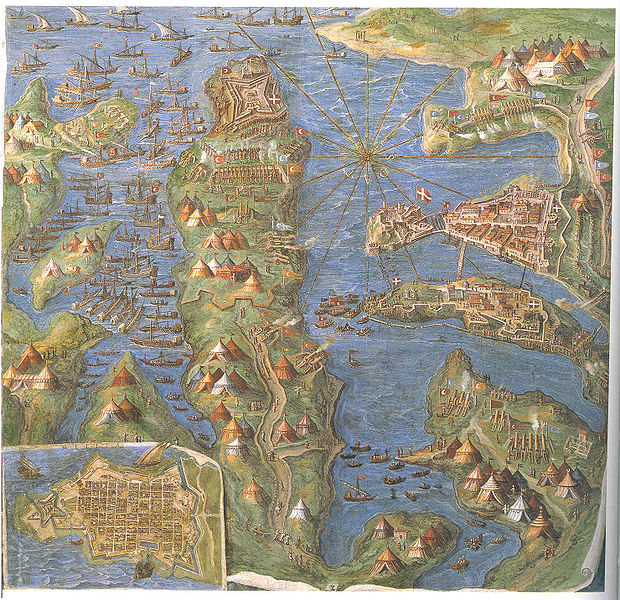On the morning of August 18th the excessively heavy bombardment of Senglea warned them that an attack was imminent. It was not slow to develop. The moment that the rumble of the guns died down, the Iayalars and Janissaries were seen streaming forward across the no-man’s-land to the south. The attack developed in the same way as on previous occasions, with a mass assault on the bastion of St. Michael. Piali, meanwhile, held back his troops from Birgu according to plan. Mustapha waited anxiously to see if the Grand Master was to be lured into sending some of his garrison across the bridge to reinforce hard-pressed Senglea.
La Valette clearly expected some trick, and was not to be caught. At last, having failed to draw off the Christians as he had hoped, Mustapha gave his engineers the order to spring the mine under Castile.
Although La Valette had known that the Turks were mining towards his walls he had been unable to discover the exact position. The blow, when it fell, was not unexpected but it was none-the-less devastating in its effect. With a gigantic rumbling crash the mine went up, and a great section of the main wall of the bastion fell with it. The dust cloud was still spilling outwards into the ditch, when Piali’s troops poured forward en masse.
For a moment panic ensued among the defenders. The wounded staggered back from the breach and in the general confusion it seemed as if the position was surely lost. Hardly had the smoke cleared away, than the first wave of Turks were over the ditch and had gained a foothold. Their banners were planted on the torn and tottering rampart. Their spearhead began to drive forward into the very town itself. The bell of the Conventual Church was rung—a pre-arranged signal that the enemy was within the fortifications. A Chaplain of the Order, Brother Guillaume, seeing the Turkish standards waving over Castile rushed to the Grand Master.
“All is lost,” he cried. “We must retreat to St. Angelo.” It was a moment when a flicker of indecision would have spelled ruin. La Valette, who was in his command post in the small square of Birgu, did not hesitate. “…This intrepid old man, placing only a light morion on his head and without waiting to put on even his cuirass, rushed boldly to meet the infidels.” Seizing a pike from a soldier standing nearby, he called on his staff to follow him and led the way towards the bastion of Castille.
Seeing the Grand Master at the head of a small group of Knights running towards the point of danger, the Maltese inhabitants swarmed round to lend help. The waverers and the disheartened, hearing that the Grand Master himself was leading the counter-attack, forgot their moment of fear. “Accompanied by the Knights who were immediately about his person, the Grand Master led so impetuous a charge that the tide was turned.” Up the scarred and still smoking slopes where the mine had breached the wall, La Valette led his band of Knights and townsfolk. A grenade burst alongside him and he was wounded in the leg by splinters. The cry went up, “The Grand Master! The Grand Master is in danger!” From every side Knights and soldiers came rushing to the attack. The Turkish vanguard staggered back and began to yield.
“Withdraw, Sire! Withdraw to a place of safety,” urged one of Valette’s staff. “The enemy are in retreat.”
It was true that the first impetus of the Turkish assault had spent itself. The position, though, was still far from secure. A group of their soldiers occupied the breach. Their pennants still lifted above the bastion. La Valette knew that it was his presence which had put new heart into the garrison. It was no time for him to withdraw. Limping, he went forward up the slope.
“I will not withdraw,” he said to the Knight beside him, “so long as those banners still wave in the wind.”
Knights, soldiers and Maltese from Birgu now surged forward and began to hurl the enemy down into the ditch. Within a few minutes the wall was cleared and the enemy routed. To further protestations from his staff that he should now retire, the Grand Master only replied: “I am seventy-one. And how is it possible for a man of my age to die more gloriously than in the midst of my friends and brothers, in the service of God?” Not until he had seen the whole bastion reoccupied, and the defenses re-manned, did La Valette withdraw to have the wound in his leg dressed….
As soon as his leg had been bandaged, he insisted on returning to the bastion of Castile. As he was on his way there, some Knights brought before him the Turkish flags captured in the action. He ordered them to be hung with the other trophies in the Conventual church, then made his way back to the bastion.
The Grand Master knew that, after breaching the wall so successfully, the enemy was almost certain to attack again—possibly that very night. He was proved right in his conjecture. Mustapha and Piali, having called off their attacks on the two garrisons during the afternoon, renewed the offensive soon after sunset.
It was a night without darkness. From the mouth of Grand Harbor where the ships under Candelissa had begun to close in towards Bighi Bay, came the rippling flash of gunfire. From all the ridges and hills around Senglea and Birgu, the rumble of cannon was like a summer thunderstorm. Soon the enemy brought up incendiary flares, and the ground below the walls became as bright as day. Wildfire poured down from the ramparts of Castile and St. Michael. Incendiary grenades burst with a smoke and flare among attackers and defenders alike. Silhouetted in the breach, the figure of the Grand Master was a rallying point for his men—a rallying point like a rock round which the storm rages. But when the dawn came and the Turks withdrew, the two fortresses were still in the hands of the defenders.
Ernle Bradford, The Great Siege: Malta 1565 (Ware, Hertfordshire, U.K: Wordsworth Editions Limited, 1999), pp. 184-187.
Posted with the kind permission of A. M. Heath & Co., 6 Warwick Court, London WC1R 5DJ
 To read Michael Whitcraft’s review of The Great Siege and buy this wonderful book, click here
To read Michael Whitcraft’s review of The Great Siege and buy this wonderful book, click here
Short Stories on Honor, Chivalry, and the World of Nobility—no. 101













